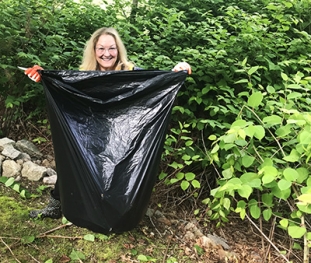
Suzanne Thompson didn’t wake up on the first day of 2020 thinking about Japanese knotweed. But, after all, it is 2020—and stranger things have happened than the turn Thompson took in May of that year, when she founded an all-volunteer campaign to fight back at that awful plant.
Says Thompson, “We don’t spray it. We cut it.” Then she adds, “We starve it.”
In the horticultural world, the technique Thompson describes is sometimes called “carbohydrate deprivation.” The theory behind it is simple: Deprive a plant of its leaves and you deprive it of photosynthesis, the source of its food. The method works quickly on annual plants, and much more slowly on tough, mega-rooted plants like Japanese knotweed (JK).
“It is crowding out our native species,” says Thompson. “And it takes up the spaces that are needed to support our birds, butterflies, other pollinators and wildlife.”
Knotweed spreads aggressively through roots and runners.
“That’s why it is not enough to cut and run,” says Thompson. The cuttings must be bagged and incinerated. “The cuttings sprout prolifically,” she emphasizes, “like the brooms in the old Sorcerer’s Apprentice animation. If you mow or weed whack JK, you’re only spreading it more, not stopping it,” she says. The plant also spreads through seeds.
Thompson concludes, “This is the classic invasive species that thrives and spreads here because there aren’t any natural predators to keep it in check. Deer won’t even eat it.”
Email Suzanne Thompson at suzanne.s.thompson@sbcglobal.net.
Learn more about Nix the Knotweed at Zip06/TheDay.

